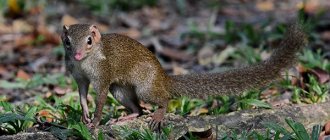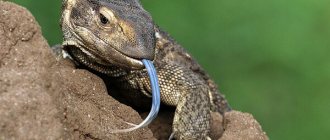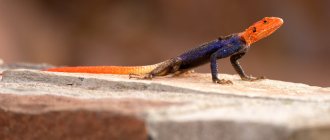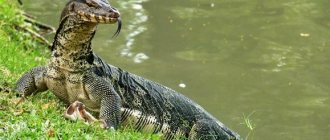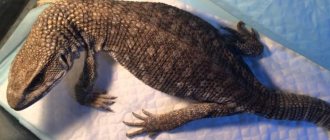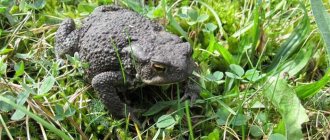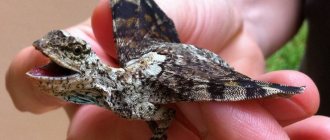Description
The striped monitor lizard can grow up to 3 meters in length, but most mature individuals have an average body length of no more than 1.5 meters. Their neck is quite long with an oblong muzzle. The nostrils are close to the end of the nose. The tail is laterally compressed and has a dorsal keel. The scutes on the top of the head are larger than those on the back. The color of striped monitor lizards is dark brown or black, with yellow spots on the lower part of the body. Typically, the number of yellow spots decreases with age.
Natural habitat and lifestyle
Reptiles can be found in India, Sri Lanka, the Philippines, Bangladesh, other Southeast Asian countries, and Southern China. They lead an active daily lifestyle. They spend a lot of time in or near water. At night and in very hot weather they hide in water or vegetation. When the temperature drops, they become active again.
Source: yandex.ru
Juveniles live in trees. When they become sexually mature, they descend to land and lead an aquatic-land lifestyle. However, they still spend more time in the pond. They are excellent swimmers and can dive. When stationary, they can spend 30 minutes under water, while moving - 10 minutes.
Source: yandex.ru
The water monitor is a predator. It feeds on other reptiles, mammals, eggs, and fish. He will not refuse carrion either.
Nutrition
Striped monitor lizards lead a predatory lifestyle and can eat any animal they can handle. The basis of their diet consists of: birds, eggs, small mammals (especially rats), fish, lizards, frogs, snakes, young crocodiles and turtles. It is known that the striped monitor lizard, like the Komodo dragon, is capable of digging up the corpses of people and devouring them.
The primary hunting technique used by the striped monitor is characterized by open pursuit and hunting rather than stalking and ambush. These are very fast animals with powerful leg muscles. While hunting for aquatic inhabitants, the striped monitor lizard is able to remain under water for up to half an hour.
Keeping at home
Exotic lovers are not against having this creature as a pet. But given its size and specifics in maintenance and feeding, you need to think carefully before getting such a pet. Although, compared to other predators, they are relatively harmless to humans and can be tamed quite well. According to owners, these reptiles are only interested in two things: plenty of food and clean water in the pool.
Read about the types, conditions and features of keeping a domestic monitor lizard.
Terrarium
Like all large reptiles, the striped monitor lizard requires a fairly large terrarium. Young animals can be kept in a small terrarium (70x70x50 cm), but since they grow quickly, it will have to be replaced with larger containers.
A terrarium for an adult must meet the following requirements:
- An adult animal must have at least 6 m². Accordingly, the dimensions of the housing should be no less than 3 × 3 × 2 m. A third of the space should be occupied by a pond, giving the opportunity not only to lie down, but also to swim. It would be nice if the pool is equipped with a filtration system.
- The bottom is covered with gravel or sand. Mulch is also well suited for this purpose, as it helps maintain the necessary moisture. It is convenient to burrow into it, which will allow the animal to feel safe. The substrate must be sprayed regularly using a sprinkler or sprayer.
- The indoor environment for the lizard should be as close to natural as possible, so it is necessary to have shelters, caves, snags or logs. Even if the animal hides not completely, but partially, it will be much more comfortable. It is also advisable to place more different plants (preferably tropical ones). They can be buried in the substrate along with the pots.
- Fluorescent lamps are well suited for lighting. Lamps with UVA and UVB radiation will help produce vitamin D.
- It is very important to have several temperature zones. In the warming up zone, the temperature should be about +39–40 °C, and in the rest of the zone - +29–30 °C during the day and about +25 °C at night. To make the animal more comfortable in the warming zone, you can place a stone or driftwood in it.
- The tropics have made monitor lizards moisture-loving, so the humidity should not fall below 80%. Otherwise, skin problems are inevitable.
Important! The temperature in the reservoir should be maintained at +25–28 °C.
Feeding ration
Monitor lizards are completely unpretentious in food, but are very gluttonous. Suitable food for them:
- fresh meat and flavored meat (they are not affected by cadaveric poisons);
- rodents, frogs, insects, worms, fish, chickens and everything “meaty”;
- quail and chicken eggs;
- vitamin and mineral supplements.
You need to feed your lizard a variety of foods. She eats everything, and in unlimited quantities, but it is better not to overfeed her, so that there is no obesity and other related diseases. The optimal regimen is feeding once a day or every other day. The babies are fed daily. The feeding place is chosen in the shade. As for water, it must be constantly fresh and clean.
Economic value for humans: Positive
The skins of striped monitor lizards are used as a source of dietary protein, in ritual ceremonies, traditional medicine and for sewing leather goods. The annual turnover of trade in striped monitor lizard skins can reach more than 1 million whole skins, mainly for the leather trade. Medium-sized specimens are preferred because the skin of large monitor lizards is too tough and thick to process. There is a small trade in live striped monitor lizards, but they are not suitable pets for most owners.
Reproduction
Sexual maturity occurs in individuals that have reached sizes of 1.2 m (in females) and 1.3 m (in males). This most often occurs at the age of 2 years. In India and Sumatra, animals up to 1 m in size are considered sexually mature. Females are very fertile. In Thailand, they lay eggs in June, when the rainy season begins. In regions with a good food supply and without severe periods of drought and rain, breeding occurs all year round, but the main period is from April to October. There are from 15 to 20 eggs in a clutch. Over the course of a year, a female can make several clutches. The oviposition site is hollows, burrows or termite mounds located near water. In their absence, the female digs a hole and builds a nest in it, which she covers with leaves and other plant debris that release heat during decomposition.
The duration of incubation may vary. Depending on conditions, incubation lasts 7–9 months. Hatching of the cubs is possible only if there is a sufficient amount of precipitation, otherwise a resting phase begins. Under favorable conditions at a temperature of +30 °C, the incubation period is 180–320 days. The length of the babies at birth is about 30 cm, and their weight is 20–50 g. The hatched offspring are very shy, so it is almost impossible to meet them in nature.
Did you know? Male monitor lizards participate in ritual battles for the female. Standing on their hind limbs and clasping each other with their front limbs, they try to throw their opponent to the ground. Such battles can take place both on land and in water.
Leatherback sea turtle (Dermochelys coriacea)
The largest of all turtles: its length can reach 2.5 m and weight – 900 kg. Unfortunately, the population of these omnivorous creatures is declining. It is not recommended to disturb the tranquility of these rather gentle giants, as they are capable of breaking bones with one crushing blow. There was a case when one turtle barely broke away from the sharks pursuing it and sank a small boat that got in its way, perceiving it as a threat.
Gray monitor lizard: features of the lizard
The position of the monitor lizard in the evolutionary series is not entirely clear, but most zoologists believe that snakes evolved from monitor lizards. Indeed, monitor lizards living today have a lot in common with snakes: the brain of both is enclosed in a bone capsule, the neck is significantly elongated, the tongue is long and deeply forked, like that of snakes. In addition, similar signs were noted in the structure of the heart and the microstructure of the stomach. Some of the habits of monitor lizards resemble those of a snake. Thanks to the extensibility of the neck and throat, the monitor lizard can swallow large prey and eats by moving its mouth towards the victim
Particularly noteworthy is the fact that the saliva of the gray monitor lizard is poisonous, and its bite causes the same processes in the human body as snake venom
The monitor lizard is a fast and agile lizard. It can briefly reach speeds of up to 20 km/h, makes sudden and sharp turns, and climbs trees quite well, where it usually climbs for the eggs and chicks of birds nesting there. Despite the fact that the monitor lizard is a desert animal, it swims well, in captivity willingly drinks water and loves to swim.
The monitor lizard is unusually tenacious - it is difficult to put it to sleep in ether vapor. In addition, it can remain under water for a long time. In moments of danger, it strives to hide in a hole, and if this is impossible, it presses itself to the ground and lies motionless.
The threat pose performed by the monitor lizard is very impressive - it rises on its limbs, inflates its throat, opens its mouth wide, sticks out its tongue and begins to swing its tail from side to side, while loudly hissing, periodically drawing air into its lungs and releasing it forcefully.
The gray monitor lizard is characterized by one exceptional phenomenon. Special studies have shown that it is able to tolerate huge doses of cobra and viper venom with absolutely no harm to itself. His behavior after the bite does not change and there are no signs of poisoning. There is no swelling or hemorrhage at the site of the bite, and soon its traces disappear completely. As scientists have established, the monitor lizard can tolerate up to 200 doses of viper venom that are lethal to humans and up to 4,000 doses of cobra venom. This feature gives him the ability to hunt large poisonous snakes. In Turkmenistan, for example, it eats cobras and vipers more than a meter in length.
In nature, the gray monitor lizard lives 7-8 years. The long-lived monitor lizard is also known - the gray monitor lizard was kept in the Leningrad Zoo for 17 years.
Fringed turtle, or Mata-Mata (Chelus fimbriatus)
These creatures live in South America, in river basins from the Orinoco to the Amazon, sharing water space with river dolphins and piranhas. What will happen to a person who is unlucky enough to step on it is unknown, but this reptile with a bizarre appearance has an elongated snake-like neck and a strange mouth filled with two sharp plates reminiscent of fused human teeth. The unusually creepy carnivores hunt waterbirds, fish and other reptiles.
Venomtooth (Helodermatidae)
The only venomous lizard in the animal world, it is the largest in North America, usually reaching a length of more than 0.6 m. When disturbed, the reptile can fend for itself: the poisonous lizard grabs the legs or arms of its enemy, then plunges its teeth into them and quickly releases its extremely neurotoxic venom . Several deaths occurred after encounters with venom teeth until scientists were able to develop a treatment. These lizards do not have fangs, so they use enormous strength, slowly chewing a human hand and leaving behind flesh soaked in poison. If you immerse a reptile in water, there is a chance that it may release its prey. Representatives of the family of vultures are endangered and protected by law.
Large softshell turtle (Pelochelys bibroni)
What it lacks in shell it makes up for with a powerful bite. The most terrible individuals - the giant soft-bodied Cantor turtles - are common in China. Hiding in the sand, they wait for their prey and then strike it with their sharp teeth. Due to its enormous size and bite force, it is a real threat to the unwary person. Unfortunately, this reptile species is endangered.
Big-headed turtle (Platysternon megacephalum)
It is the only species of the genus of the same name from the family of snapping turtles. It got a rather strange appearance due to its long, snake-like tail, almost as long as its body. Habitat: Southeast Asia. The freshwater reptile cannot retract its large head into its shell, which is compensated by its very powerful jaws, so it is better to keep your distance from it. Able to climb trees, sitting on branches as a perch. Unfortunately, this species of reptile is endangered due to poaching.
